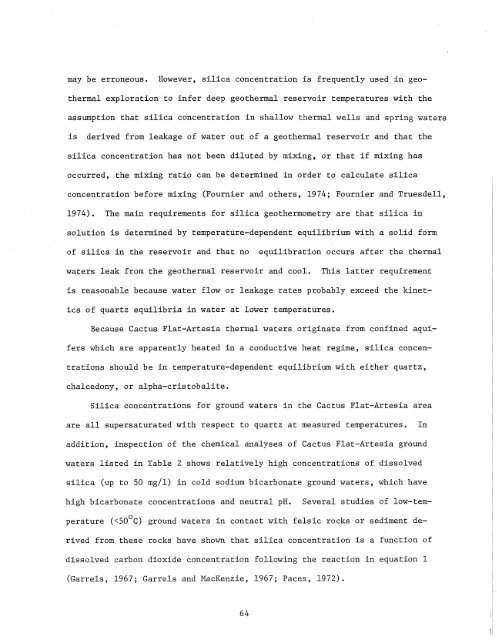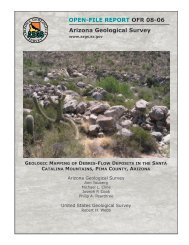geothermal resource potential of the safford-san simon basin, arizona
geothermal resource potential of the safford-san simon basin, arizona
geothermal resource potential of the safford-san simon basin, arizona
Create successful ePaper yourself
Turn your PDF publications into a flip-book with our unique Google optimized e-Paper software.
may be erroneous. However, silica concentration is frequently used in <strong>geo<strong>the</strong>rmal</strong><br />
exploration to infer deep <strong>geo<strong>the</strong>rmal</strong> reservoir temperatures with <strong>the</strong><br />
assumption that silica concentration in shallow <strong>the</strong>rmal wells and spring waters<br />
is<br />
derived from leakage <strong>of</strong> water out <strong>of</strong> a <strong>geo<strong>the</strong>rmal</strong> reservoir and that <strong>the</strong><br />
silica concentration has not been diluted by mixing, or that if mixing has<br />
occurred, <strong>the</strong> mixing ratio can be determined in order to calculate silica<br />
concentration before mixing (Fournier and o<strong>the</strong>rs, 1974; Fournier and Truesdell,<br />
1974). The main requirements for silica geo<strong>the</strong>rmometry are that silica in<br />
solution is determined by temperature-dependent equilibrium with a solid form<br />
<strong>of</strong> silica in <strong>the</strong> reservoir and that no<br />
equilibration occurs after <strong>the</strong> <strong>the</strong>rmal<br />
waters leak from <strong>the</strong> <strong>geo<strong>the</strong>rmal</strong> reservoir and cool.<br />
This latter requirement<br />
is reasonable because water flow or leakage rates probably exceed <strong>the</strong> kinetics<br />
<strong>of</strong> quartz equilibria in water at lower temperatures.<br />
Because Cactus Flat-Artesia <strong>the</strong>rmal waters originate from confined aquifers<br />
which are apparently heated in a conductive heat regime, silica concentrations<br />
should be in temperature-dependent equilibrium with ei<strong>the</strong>r quartz,<br />
chalcedony, or alpha-cristobalite.<br />
Silica concentrations for ground waters in <strong>the</strong> Cactus Flat-Artesia area<br />
are all supersaturated with respect to quartz at measured temperatures.<br />
In<br />
addition, inspection <strong>of</strong> <strong>the</strong> chemical analyses <strong>of</strong> Cactus Flat-Artesia ground<br />
waters listed in Table 2 shows relatively high concentrations <strong>of</strong> dissolved<br />
silica (up to 50 mg/l) in cold sodium bicarbonate ground waters, which have<br />
high bicarbonate concentrations and neutral pH.<br />
Several studies <strong>of</strong> low-temo<br />
perature «50 C)<br />
ground waters in contact with felsic rocks or sediment derived<br />
from <strong>the</strong>se rocks have shown that silica concentration is a function <strong>of</strong><br />
dissolved carbon dioxide concentration following <strong>the</strong> reaction in equation 1<br />
(Garrels, 1967; Garrels and MacKenzie, 1967; Paces, 1972).<br />
64

















